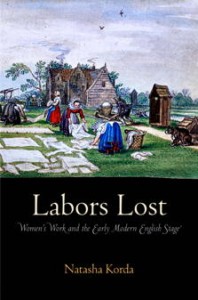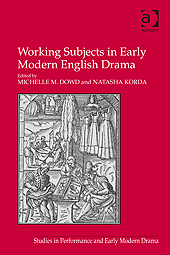5 Questions With . . . Natasha Korda on “the Women Behind the Scenes”

This issue we ask “5 Questions” of Natasha Korda, professor of English, professor of Feminist, Gender and Sexuality studies. Korda’s book, Labors Lost: Women’s Work and the Early Modern English Stage, was published by the University of Pennsylvania Press in September 2011. She also co-edited a book, Working Subjects in Early Modern English Drama, published by Ashgate in February 2011.
Q: Professor Korda, you’ve taught English and gender studies at Wesleyan since 1995, and you were promoted to full professor in 2010. What courses do you teach and what are your scholarship interests?
A: My area of expertise is Renaissance literature and culture, particularly the work of Shakespeare and his contemporaries, and my scholarship focuses on the subjects of labor and property, especially women’s labor and property, in Elizabethan and Jacobean dramatic literature and theater history. At Wesleyan, in addition to the Shakespeare lecture and introductory courses like “Shakespeare on Film” and “Renaissance Drama,” I have taught advanced seminars cross-listed with the Feminist, Gender and Sexuality Studies Program, including “Historicizing Early Modern Sexualities” and “Staging Race in Early Modern England.” This spring, while on sabbatical, I will be teaching a graduate seminar at the Folger Shakespeare Library in Washington, D.C., on “Mastering Research Methods at the Folger.”

Q: You’re the author/editor of more than 20 articles and four books including Shakespeare’s Domestic Economies: Gender and Property in Early Modern England (2002) and Staged Properties in Early Modern English Drama (2002). Your newest book, Labors Lost: Women’s Work and the Early Modern English Stage (2011) argues that the purportedly “all-male” stage of Shakespeare’s time relied on the labor, capital and ingenuity of women behind the scenes of theatrical production. In what ways did women contribute, and how were they acknowledged?
A: The rise of the professional stage in England relied on women of all stripes, including ordinary crafts- and tradeswomen who supplied costumes, properties and comestibles; wealthy heiresses and widows who provided much-needed capital and credit; wives, daughters and widows of theater people who worked actively alongside their male kin; and immigrant women who fueled the fashion-driven stage with a range of newfangled skills and commodities. The work of female seamstresses, laundresses, dressers (known as “tirewomen”), wigmakers and head-dressers, among others, was woven into the very fabric of player’s costumes, congealed in the folds of their starched ruffs, set into the curls of their perukes, and arranged in the petticoats of boy-actors, while the terms of female moneylenders were calculated in the playing-companies’ balance sheets and inscribed in the terms of their bonds. Female “gatherers” collected entrance fees at the doors and galleries of theaters, while the cries of female hawkers echoed inside and outside their walls and the wares they sold were consumed in the “pit,” galleries, and on the stage.
Although traces of women’s work were thus everywhere in the professional theater as in the culture at large, they often went unnoticed or unacknowledged—or were in varying ways stigmatized. The historical invisibility of women’s work in early modern English culture—its relegation behind the scenes of both theatrical and craft production to a “shadow” or informal economy—was produced by innumerable cultural forces and mechanisms of erasure. Women’s luxury textile manufacture, for example, was often decried by Puritans as the devil’s work. Similar attacks were mounted by guildsmen who sought to stigmatize female labor outside the guild-system as shoddy or unskilled.
Q: Where did you develop the idea for the book, and where did you conduct your research?
A: The book began with a simple question: what roles, if any, did women play in the “all-male theater” of Shakespeare’s time? Having stumbled across women’s credit activities in the networks of commerce surrounding the professional stage while researching the “diary” or account-book of theater entrepreneur Philip Henslowe, I set out to investigate other forms of commercial activity in which women were involved and how they may have contributed to theatrical production. Some of these contributions were hiding in plain sight because they had long ago been discovered by theater historians but had been dismissed as insignificant. Others emerged only after many years of research at various archives in London, the Huntington Library, and the Folger Shakespeare Library.

Q: You also co-edited a book with Michelle Dowd of the University of North Carolina- Greensboro, titled Working Subjects in Early Modern English Drama (2011). What does the book investigate?
A: Early modern England witnessed a series of remarkable economic changes—including exponential population growth, expanding global trade and consumerism, a shift from feudal to wage labor, and the declining hegemony of the guilds—that transformed the landscape of labor and the working subjects who populated it. In the midst of this dramatically shifting landscape arose London’s first professional playing companies and purpose-built theaters. Indebted both to traditional guild and patronage structures and to the innovations of a burgeoning, market economy, the professional stage was uniquely positioned to interrogate the changes wrought by the rise of capitalism and global trade. The public stage brought into heightened visibility a newly diverse range of occupational roles—including the hitherto unknown occupation of the “professional player”—and provided a platform upon which the contours and legitimacy of these roles might be explored and their social implications played out. The essays assembled in this collection investigate the staging of working subjects, and interrogation of the subject of work itself, in a broad range of dramatic genres, including history plays, comedies, tragedies, tragicomedies, travel plays, royal progress entertainments and civic pageants.
Q: What are some of the essay topics included in the book? What essays did you personally contribute to the book?
A: The essays focus on a range of topics, including the labor networks associated with the public theaters, acting as labor, women’s work, labor and citizenship, global networks of trade, indentured servitude and slavery. Taken together, they offer a clearer understanding of the complex ways in which the stage reimagined England’s labor economy and its own place within that economy. In addition to co-editing the volume and co-authoring the introduction, I contributed an essay on the staging of immigrant women’s textile work in civic pageants. Massive numbers of Dutch- and French-speaking refugees emigrated to England during the religious wars of Shakespeare’s time, bringing sophisticated skills and technologies in luxury textile manufacture with them that transformed contemporary fashion trends and the fashion-driven stage. In contrast to plays performed in the public theaters by London’s all-male playing companies, in which alien craftswomen were often depicted in xenophobic and misogynistic terms, the civic pageants staged by the immigrant textile workers themselves for Queen Elizabeth and King James sought to defend their contribution to the commonwealth, and highlight the active role played by female artisans in manufacturing their “New Draperies.”

